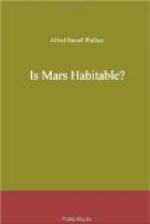CHAPTER VII.
A SUGGESTION AS TO THE ‘CANALS’ OF MARS.
The special characteristics of the numerous lines which intersect the whole of the equatorial and temperate regions of Mars are, their straightness combined with their enormous length. It is this which has led Mr. Lowell to term them ‘non-natural features.’ Schiaparelli, in his earlier drawings, showed them curved and of comparatively great width. Later, he found them to be straight fine lines when seen under the best conditions, just as Mr. Lowell has always seen them in the pure atmosphere of his observatory. Both of these observers were at first doubtful of their reality, but persistent observation continued at many successive oppositions compelled acceptance of them as actual features of the planet’s disc. So many other observers have now seen them that the objection of unreality seems no longer valid.
Mr. Lowell urges, however, that their perfect straightness, their extreme tenuity, their uniformity throughout their whole length, the dual character of many of them, their relation to the ‘oases’ and the form and position of these round black spots, are all proofs of artificiality and are suggestive of design. And considering that some of them are actually as long as from Boston to San Francisco, and relatively to their globe as long as from London to Bombay, his objection that “no natural phenomena within our knowledge show such regularity on such a scale” seems, at first, a mighty one.
It is certainly true that we can point to nothing exactly like them either on the earth or on the moon, and these are the only two planetary bodies we are in a position to compare with Mars. Yet even these do, I think, afford us some hints towards an interpretation of the mysterious lines. But as our knowledge of the internal structure and past history even of our earth is still imperfect, that of the moon only conjectural, and that of Mars a perfect blank, it is not perhaps surprising that the surface-features of the latter do not correspond with those of either of the others.
Mr. Pickering’s Suggestion.
The best clue to a natural interpretation of the strange features of the surface of Mars is that suggested by the American astronomer Mr. W.H. Pickering in Popular Astronomy (1904). Briefly it is, that both the ‘canals’ of Mars and the rifts as well as the luminous streaks on the moon are cracks in the volcanic crust, caused by internal stresses due to the action of the heated interior. These cracks he considers to be symmetrically arranged with regard to small ‘craterlets’ (Mr. Lowell’s ‘oases’) because they have originated from them, just as the white streaks on the moon radiate from the larger craters as centres. He further supposes that water and carbon-dioxide issue from the interior into these fissures, and, in conjunction with sunlight, promote the growth of vegetation. Owing to the very rare atmosphere, the vapours, he thinks, would not ascend but would roll down the outsides of the craterlets and along the borders of the canals, thus irrigating the immediate vicinity and serving to promote the growth of some form of vegetation which renders the canals and oases visible.[13]




